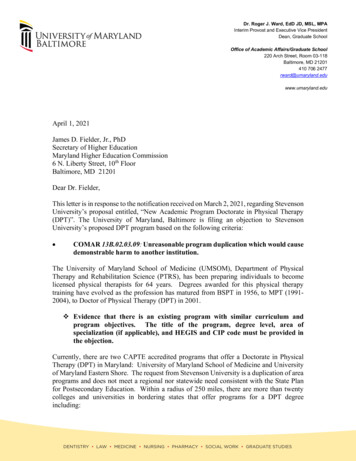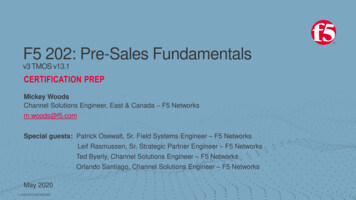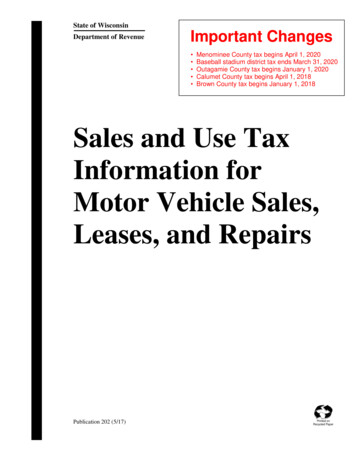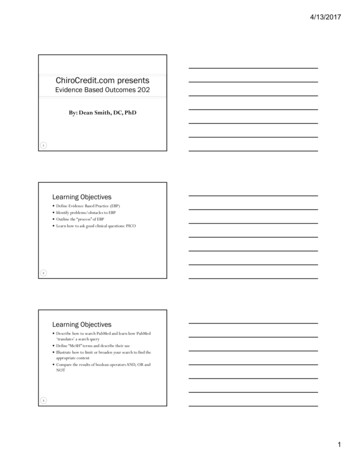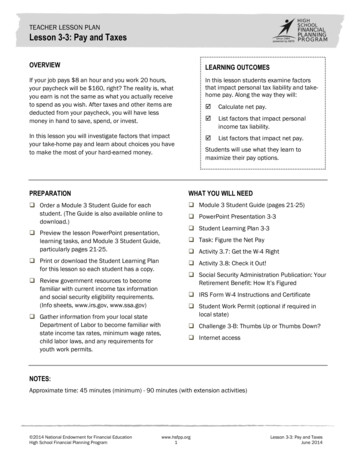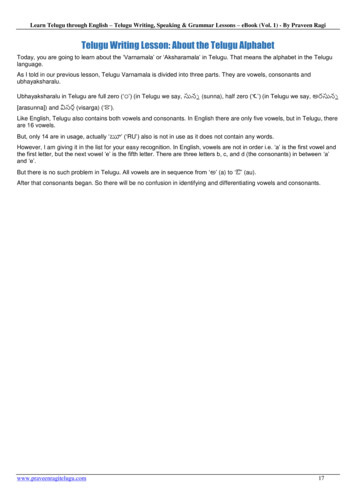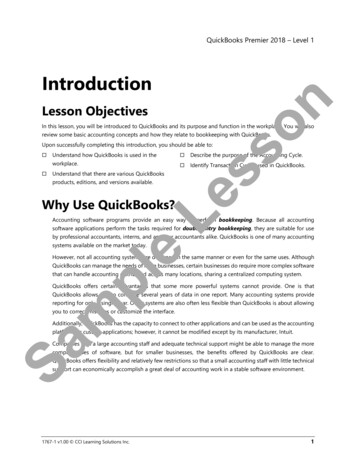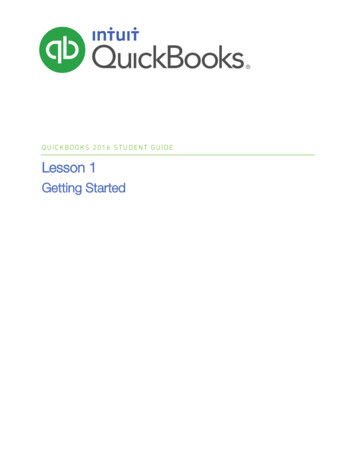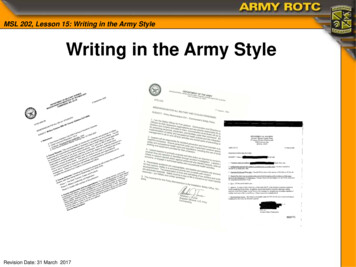
Transcription
MSL 202, Lesson 15: Writing in the Army StyleWriting in the Army StyleArmy Memo collageRevision Date: 31 March 2017
MSL 202, Lesson 15: Writing in the Army StyleBUFORD’S MESSAGE TO REYNOLDSGETTYSBURG (1863)Revision Date: 31 March 2017
MSL 202, Lesson 15: Writing in the Army StyleLearning Objectives Describe the Army writing standards IAW AR25-50 Explain the meaning and importance of BLUF Understand how to write in the active voice Explain the steps in the writing processRevision Date: 31 March 2017
MSL 202, Lesson 15: Writing in the Army StyleArmy Leadership Requirements ModelADP/ADRP 6-22Revision Date: 31 March 2017
MSL 202, Lesson 15: Writing in the Army StyleArmy Writing Style Guide BLUF: Bottom Line Up Front: Put the recommendation,conclusion or reason for writing -- the bottom line -- in the first orsecond paragraph, not at the end Use the active voice Concise, organized, to the point Use correct spelling, grammar, and punctuation Write in the first person using “I,” “you” and “we” as subjects ofsentences instead of “this office,” “this headquarters,” “allindividuals,” and so forth, for most types of writing Convey a clear message in single, rapid reading Use Respectful, Professional ToneRevision Date: 31 March 2017
MSL 202, Lesson 15: Writing in the Army StyleSpell Check PoemSpell check is only a tool and is not infallible, AR 25-50The Spelling Chequer (or poet tree without mist takes)Eye have a spelling chequerIt came with my pea seaIt plainly marks four my revueMiss steaks eye cannot seeEach thyme when I have struct the quaysEye weight four it two sayIf watt eye rote is wrong or riteIt shows me strait a weighAs soon as a mist ache is maidIt nose bee fore too lateAnd eye can put the error riteEye really fined it grateI've run this poem threw itI'm sure your policed to noIt's letter perfect in its weighMy chequer tolled me sew- Author UnknownRevision Date: 31 March 2017
MSL 202, Lesson 15: Writing in the Army StyleArmy Writing Standards BottomLine-Up Front (BLUF) Straight to the Point Clear and Concise Explain Reasoning After BLUFRevision Date: 31 March 2017
MSL 202, Lesson 15: Writing in the Army StyleActive Voice It is a stronger form of expression because it indicates the Agent andshows the action It states the action in fewer words It prevents confusion about the actor. Use of “I” and “We; the first persontakes responsibility for the action PASSIVE - The subject of the sentence names the receiver of theaction. ACTIVE -The subject of the sentence names the receiver of the actionPASSIVE RECEIVER ---VERB --- DOERAll weapons will be zeroed before qualification.ACTIVE DOER --- VERB --- RECEIVERAll qualifiers will zero their weapons before qualification.Revision Date: 31 March 2017
MSL 202, Lesson 15: Writing in the Army StyleActive Voice (cont.) NOT: Three teams were formed BUT: LTC Jones formed three teams NOT: A TDY is requested by BUT: LTC Jones requests a TDY NOT: The M4 was fired by PFC Smith BUT: PFC Smith fired the M4 NOT: The M4 was fired by PFC Smith BUT: PFC Smith fired the M4 NOT: The HMMWV was wrecked by PVT Jones. BUT: PVT Jones wrecked the HMMWVRevision Date: 31 March 2017
MSL 202, Lesson 15: Writing in the Army StylePractical ExerciseInstructions:1) Divide the class into groups of 3-5 Cadets.2) Distribute PE to each group3) Have the groups review the PE and determineand rewrite the sentence into active voice ifapplicable.4) Allow Cadets 3-5 minutes to complete the PE5) Have one Cadet from each group present andexplain their responsesRevision Date: 31 March 2017
MSL 202, Lesson 15: Writing in the Army StyleThe Elements of Effective Writing Substance – Control and support of youridea; most important element Organization – clear and concise; flow Style – format, vocabulary, “package” Correctness – grammar, spellingRevision Date: 31 March 2017
MSL 202, Lesson 15: Writing in the Army StyleFive Step Writing Process # 1Step 1: Research - Research is the gatheringof ideas and information. This is the step whereyou answer the "who, when, where, what, andhow of the issue". Since we gather informationin different ways, you must find the systemwhich best suits you and your task. Ensure youdocument your sources.Revision Date: 31 March 2017
MSL 202, Lesson 15: Writing in the Army StyleFive Step Writing Process # 2Step 2: Plan- The planning step is where you takeall the information you’ve gathered and put it into alogical order. Start by placing your ideas intogroups. Then order your groups in the way thatbest supports your task. The product that results isthe outline.Revision Date: 31 March 2017
MSL 202, Lesson 15: Writing in the Army StyleFive Step Writing Process # 3Step 3: Develop a Draft- The draft is thebridge between your idea and the expressionof it. Write your draft quickly and concentrateonly on getting your ideas down on paper.Don’t worry about punctuation and spelling.Use your outline to develop your draft.Revision Date: 31 March 2017
MSL 202, Lesson 15: Writing in the Army StyleFive Step Writing Process # 4Step 4: Revise- Revising is looking at thematerial through the eyes of your audience.Read the paper as if you have never seen itbefore. Find where you need to put intransitions; look for places that need moreevidence. This will help you decide if you needto add enclosures or add informationdepending on the type of written product youare developing.Revision Date: 31 March 2017
MSL 202, Lesson 15: Writing in the Army StyleFive Step Writing Process # 5Step 5: Proof- Now you are ready to proofyour draft. At this point concentrate on theformat, grammar, mechanics, and usage. Youmay want to have someone else read it.Sometimes others can find errors you can’tbecause you are too close to the product.When you finish, write the final version, makingthe corrections.Revision Date: 31 March 2017
MSL 202, Lesson 15: Writing in the Army StyleThe onStep 1 - ResearchStep 2 - PlanStep 3 - DraftTransmits a clearmessage in a singlerapid reading.StyleCorrectnessStep 4 - ReviseStep 5 - Proof.generally free oferrors in grammar,mechanics, andusageRevision Date: 31 March 2017
MSL 202, Lesson 15: Writing in the Army StyleWritten CommunicationsMajor Types Memorandums Operations Orders (OPORDs) EndorsementsRevision Date: 31 March 2017
MSL 202, Lesson 15: Writing in the Army StyleTypes of Memorandum Formal Memos External to HQ, Command, Installation or DOD Personnel actions Appreciation and Commendations Informal Memos Internal to HQ, Command, Installation, or DOD Special Purpose Memos Memorandum of Understanding (MOU) Memorandum of Agreement (MOA) Memorandum for Record (MFR)Revision Date: 31 March 2017
MSL 202, Lesson 15: Writing in the Army StyleMemorandum Format AR 25-50,Chaps, 2-4Heading: The heading has five elements- Heading Body ClosingRevision Date: 31 March 2017Heading: Five elements Office symbol Date Suspense date MEMORANDUM FOR line Subject lineBody:Begin the memorandum with a short, clear purpose sentence. Put therecommendation, conclusion, or most important information (the main point)next. (Some writing combines the purpose and the main point.)Clearly separate each major section. Use paragraphs, headings, or sections.When appropriate, a point of contact (POC) line will be the last paragraph of thebody of the correspondence.Closing: Major elements are the Authority line Signature block Enclosure listing
MSL 202, Lesson 15: Writing in the Army StyleTake Home Quiz Work alone Rewrite the statements on each handoutusing the Army writing style Write a memorandum according toinstructions on the quiz sheetRevision Date: 31 March 2017
MSL 202, Lesson 15: Writing in the Army StyleClosingReview Learning Objectives Explain the meaning and importance of BLUF Understand how to write in the active voice Describe the Army writing standards IAW AR 25-50 Explain the steps in the writing processQuestionsNext Lesson:Subsequent Lesson:CADET POST-CLASS ASSIGNMENT Complete Quiz and turn in prior to next classRevision Date: 31 March 2017
MSL 202, Lesson 15: Writing in the Army Style Revision Date: 31 March 2017 Active Voice It is a stronger form of expression because it indicates the Agent and shows the action It states the action in fewer words It prevents confusion about the actor. Use of “I” and “We;
